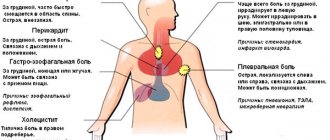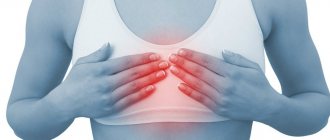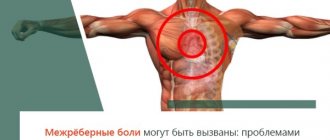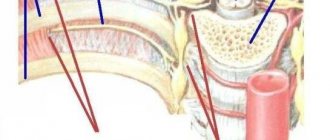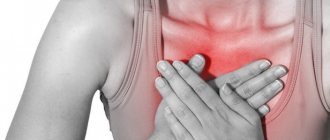Make an appointment by phone: +7 (343) 355-56-57
+7
- About the disease
- Cost of services
- Sign up
- About the disease
- Prices
- Sign up
Chest pain is a serious symptom and a reason to see a doctor.
Localization of pain in the left half of the chest and in the left breast is often associated with pathology of the cardiovascular system, although it may be due to a number of other reasons.
Spinal problems
Chest pain when inhaling often appears due to pathologies of the spinal column. The fact is that the spine contains a huge number of nerve endings, inflammation and/or infringement of which can lead to pain radiating into the chest, causing pain when inhaling.
Osteochondrosis
It is a serious disease that affects the cartilage tissue of the spinal column. The intervertebral discs thin out and become less durable, resulting in a decrease in the distance between the vertebrae. Because of this, nerve tissue is pinched, which leads to pain. If the pain intensifies when you inhale, this may indicate that the thoracic spine is affected.
Intercostal neuralgia
Sharp acute pain in the chest when inhaling occurs when compression or irritation of the nerve roots that are located between the ribs occurs. This condition can last literally a couple of minutes or drag on for a day, preventing the person from taking a deep breath and causing significant discomfort. The pain can come on suddenly, for no apparent reason, and often makes a person worry and think that the heart is stabbing, although the reason is completely different.
Fractured ribs
If you have recently been injured and experience pain in your chest when you inhale, you may suspect a rib fracture. This is a dangerous condition, and with a visit to a traumatologist
/
the surgeon
cannot hesitate, since, among other things, you may have damage to internal organs. The fracture itself, depending on its severity, can provoke additional damage.
Chest pain in children
Whooping cough
Gastritis
Ulcer
14867 March 11
IMPORTANT!
The information in this section cannot be used for self-diagnosis and self-treatment.
In case of pain or other exacerbation of the disease, diagnostic tests should be prescribed only by the attending physician. To make a diagnosis and properly prescribe treatment, you should contact your doctor. Chest pain in children: causes of occurrence, what diseases it occurs with, diagnosis and treatment methods.
Definition
The physiological significance of any pain is associated with the protection of the body from destruction, i.e. with a warning system about real or potential danger of damage. The pain signal ensures timely mobilization of the body's defenses.
When it comes to a child, his complaints of pain must be treated with special care, since children cannot always accurately characterize its specifics and even localization.
Chest pain can be caused by both intense physical activity and serious diseases of the organs located in the chest.
The sensation of pain significantly limits the activity of a small child, which can affect his psychomotor development. At an older age, pain can cause problems with the child’s socialization and adaptation in the children’s group.
Types of chest pain in children
There are acute and chronic pain, and depending on its nature - stabbing, pressing, squeezing, aching.
Possible causes of chest pain in children
Children often complain of chest pain after intense physical activity. If such complaints are isolated, then the appearance of pain can be explained by overstrain of the ligamentous apparatus - in this case, after a short rest, the pain disappears on its own and is not considered pathological.
Chest pain may result from an injury (such as a broken rib).
Pain that occurs after eating should alert parents, since it can serve as a symptom of a gastrointestinal tract disease, for example, gastroesophageal reflux, gastritis or gastric ulcer, either alone or combined with such manifestations as belching, sour taste in the mouth, heaviness in the abdomen, difficulty defecating.
Various respiratory diseases (for example, whooping cough) associated with a debilitating cough often cause chest pain in children. This is due to excessive tension in the intercostal muscles. Chest pain with pneumonia may be associated with the spread of the inflammatory process to the pleura. In this case, the child usually takes a forced position, sparing the affected side, a superficial cough and a rise in body temperature are observed.
Some diseases (lung abscess, tuberculosis) are fraught with the development of pneumothorax (accumulation of air in the pleural cavity, leading to collapse of lung tissue and compression of the blood vessels of the mediastinum).
Chest pain that occurs or worsens during movement is often a symptom of damage to the spinal nerve roots due to poor posture, scoliosis, or spina bifida.
In adolescence, chest pain is associated with intensive growth of the musculoskeletal system and delayed development of the cardiovascular and nervous systems. Such pain may be accompanied by rapid heartbeat, dizziness and other unpleasant subjective sensations in the chest.
Prolonged chest pain can be caused by infectious diseases, such as herpes zoster caused by type IV herpes. The disease is characterized by the appearance of small, profuse rashes along the affected nerve, often in the chest area. This rash is very itchy and causes significant discomfort.
Among the heart diseases that cause chest pain in children, myocarditis should be highlighted. It often develops against the background of an acute respiratory viral infection or intestinal infection (caused, for example, by the Coxsackie virus) or within two weeks after it. Young children with an unfavorable perinatal history are most susceptible to developing myocarditis. An increase in body temperature is often the first symptom of the development of myocarditis. Subsequently, shortness of breath and pain in the chest area appear, the child becomes restless, whiny, and reflex vomiting may occur.
Myocardial infarction (impaired oxygen delivery to the myocardium, leading to necrosis of the heart muscle) is an extremely rare disease in children.
A heart attack can occur as a result of atherosclerosis in familial forms of hyperlipidemia, anomalous origin of the left coronary artery, Kawasaki disease, vasculitis of the coronary arteries, and infective endocarditis. The disease is characterized by burning pain in the chest, as well as difficulty breathing, sweating, shortness of breath, and decreased blood pressure. In isolated cases, abdominal pain, vomiting, and diarrhea are noted.
If all somatic (physical) pathologies are excluded and chest pain persists, it is necessary to pay attention to the child’s mental state. Children and adolescents with anxiety and depressive disorders often complain of chest pain, palpitations and difficulty breathing.
Which doctors should I contact if I have chest pain in children?
If a child experiences chest pain, you should contact him. After an examination and medical history, the doctor will prescribe a set of laboratory and instrumental studies and consultations with specialists.
An examination by a pediatric cardiologist, orthopedist, rheumatologist, neurologist, gastroenterologist, or psychiatrist may be required.
Diagnosis and examinations for chest pain in children
In most cases, making a diagnosis requires a set of laboratory and instrumental studies, a list of which is compiled by the doctor, focusing on the patient’s condition and existing symptoms.
- Clinical blood test: general analysis with platelet count, leukoformula, ESR (with microscopy of a blood smear in the presence of pathological changes).
Diseases and pathologies of the heart
Often, when inhaling, pain appears in the left chest if there is a heart problem. In this case, there may be quite a few reasons, and only an experienced pulmonologist
.
Pericarditis
Pericarditis is an inflammation of the heart sac - the outer lining of the heart, which is called the “pericardium”. The nature of such a disease can be infectious, rheumatic, or result from a heart attack. With pericarditis, not only does pain appear when inhaling on the right or left side of the chest; the condition is often accompanied by severe weakness, as well as shortness of breath if fluid leaks between the layers of the pericardium. Pericarditis with effusion can develop into suppuration and cause compression of the heart by accumulated secretions.
Pulmonary embolism
This is the name of the condition when the pulmonary arteries stop passing blood, i.e. clogged. This is a consequence of a blood clot (thrombus), drops of fat, bone marrow, catheter element or other foreign body entering the arterial bed. In this case, when inhaling, pain occurs in the left side of the chest, and the person needs urgent medical attention.
Pulmonary pathologies
There are many causes of pain in the sternum during inspiration, which are associated with pathologies of the respiratory system. It is worth considering some cases when pain may appear when inhaling.
Pneumothorax
It is an accumulation of gas in the pleural cavity, which leads to the collapse of lung tissue, from which the process occurs. In this case, the mediastinum shifts towards the healthy organ, the blood vessels are compressed, which leads to respiratory disorders, and blood circulation is also impaired. Often pneumothorax is traumatic, and can also be a consequence of spontaneous disruption of tissue integrity.
Pleuropneumonia
If chest pain appears when taking a deep breath, this may indicate progressive pulmonary pneumonia, when the pleura is involved in the pathological process. This disease is very dangerous; Along with pain when inhaling, a person notes the inability to take a deep breath and general weakness.
Pleurisy
Inflammation of the serous membrane of the lungs is called pleurisy and may be accompanied by pain when inhaling. In this case, a person not only has pain in the chest area when inhaling, but also shortness of breath, cough, pulmonologist
notes pleural friction noise when listening to breathing, and the temperature also rises.
Lungs' cancer
Pain in the middle of the chest when inhaling can occur if a malignant neoplasm has developed in the lungs. Pain syndrome is a consequence of tissue proliferation and compression of neighboring structures. To determine why your chest begins to hurt when you inhale and move, first consult a neurologist
, who, after a survey and examination, will refer you to a specialist.
Prevention
Prevention of chest pain syndrome consists of timely contacting a doctor for the first symptoms of the disease, a healthy lifestyle and following all the recommendations of the attending physician. FEATURES OF THE COURSE OF CHEST PAIN SYNDROME
in age groups is that in older people the pain syndrome is usually less pronounced. It can be masked by shortness of breath and weakness, dizziness, and its most common cause is ischemic heart disease.
In younger patients, the list of main causes includes traumatic and inflammatory diseases of the chest, lungs, and gastroenterological pathology.
There are no differences between individuals of both sexes in the characteristics of chest pain. In pregnant women, the clinical picture of chest pain differs little from that in other individuals.
Our clinic at the New Hospital has all the necessary examinations and specialists to conduct a full examination of a patient with chest pain

